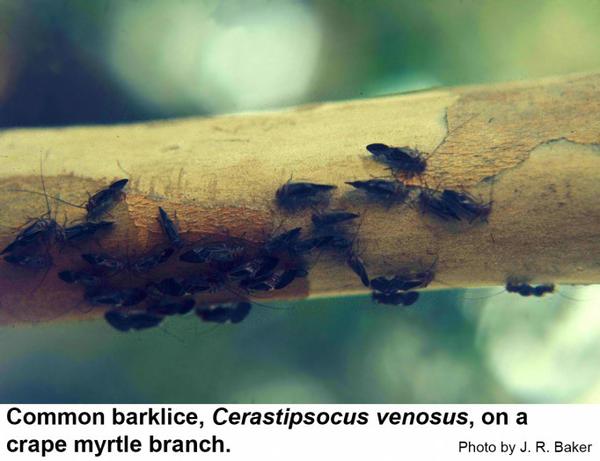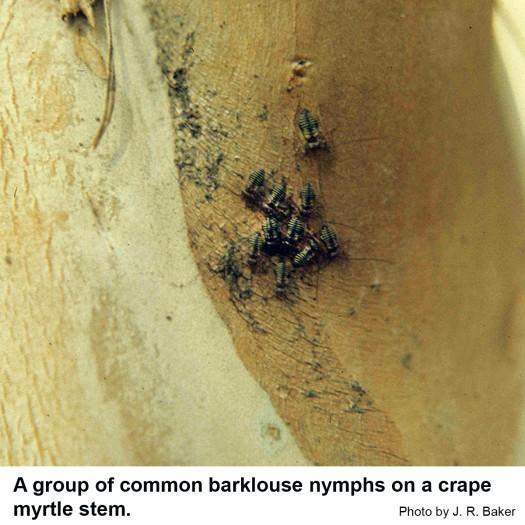Description and Biology
Common barklice, Cerastipsocus venosus, are small, fragile, sometimes strikingly marked insects that have chewing mouthparts and relatively large heads. Adults have long antennae and four wings that are held roof-like over the body. They grow to only 1/8 inch long, but are conspicuous when they band together in "herds" on the trunks of trees and shrubs (Sometimes they are referred to as bark cattle.). Females lay eggs singly or in clusters and sometimes cover the eggs with silk or debris. Nymphs hatching from eggs resemble tiny wingless adults. Most species develop through six stages. Nymphs are dark gray with pale bands between abdominal segments. Nymphs are also gregarious and cluster together on the bark. Nymphs appear in April. All stages are harmless to the shrubs and trees they live on. Bark lice sometimes live under layers of silken webbing. Barklice feed on molds, fungi, pollen, fragments of dead insects and other detritus. None of the barklice are capable of injuring plants and therefore the term "louse" is misleading.
Host Plants
Common barklice are found on the trunks and stems of various trees and shrubs where they do no harm other than alarm amatuer horticulturists. They are most often noticed on smooth-barked shrubs and trees such as crape myrtle, sycamore, and young oaks.
Residential Recommendation
Since barklice do not harm plants, no pesticide recommendation is needed. However, if control is desired, spray infested stems with water to dislodge and drown them. Any contact insecticide should give more than adequate control.
References
- Barklice. Frank, S. D. et al. 2019 (revised). Entomology Insect Notes, NC State Extension Publications.
- Barklice. Drees, B. M. and J. Jackman. 1999. Field Guide to Texas Insects. Texas A&M Agrilife Extension.
- Extension Plant Pathology Publications and Factsheets
- Horticultural Science Publications
- North Carolina Agricultural Chemicals Manual
For assistance with a specific problem, contact your local N.C. Cooperative Extension Center.
This Factsheet has not been peer reviewed.
Publication date: Dec. 13, 2013
Revised: Nov. 3, 2023
Recommendations for the use of agricultural chemicals are included in this publication as a convenience to the reader. The use of brand names and any mention or listing of commercial products or services in this publication does not imply endorsement by NC State University or N.C. A&T State University nor discrimination against similar products or services not mentioned. Individuals who use agricultural chemicals are responsible for ensuring that the intended use complies with current regulations and conforms to the product label. Be sure to obtain current information about usage regulations and examine a current product label before applying any chemical. For assistance, contact your local N.C. Cooperative Extension county center.
N.C. Cooperative Extension prohibits discrimination and harassment regardless of age, color, disability, family and marital status, gender identity, national origin, political beliefs, race, religion, sex (including pregnancy), sexual orientation and veteran status.


